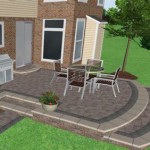Patios Con Piedras Y Plantas: Designing Harmonious Outdoor Spaces
The integration of stones and plants in patio design, often referred to as "Patios Con Piedras Y Plantas," represents a sophisticated approach to creating outdoor living spaces. This design philosophy prioritizes natural aesthetics, functionality, and ecological balance. The careful selection and arrangement of stones, coupled with the thoughtful incorporation of plant life, transform a simple patio into an inviting and sustainable environment. This article will explore the fundamental principles, design considerations, and practical applications of Patios Con Piedras Y Plantas, highlighting key elements that contribute to successful implementation.
The appeal of Patios Con Piedras Y Plantas lies in its ability to mimic natural landscapes. Stones provide structure, texture, and a sense of permanence, while plants introduce color, movement, and life. The combination creates a visually appealing and dynamic space that is both relaxing and stimulating. Moreover, these patios often require less maintenance than traditional hardscape designs, as the plants can naturally fill gaps and soften the edges of the stone elements. The overall effect is a more organic and integrated outdoor living area that enhances the connection between the built environment and the surrounding nature.
Selecting Appropriate Stone Materials
The selection of stone materials is a critical first step in designing a Patio Con Piedras Y Plantas. The choice of stone will significantly impact the overall aesthetic, durability, and maintenance requirements of the patio. Several factors must be considered, including the intended style, budget, availability of local materials, and the environmental conditions of the site.
Natural stones, such as flagstone, slate, granite, and limestone, are popular choices due to their inherent beauty, durability, and variety of colors and textures. Flagstone, with its irregular shapes and natural clefts, lends itself well to rustic and informal patio designs. Slate offers a smooth, layered surface and is available in a range of muted tones, making it suitable for more contemporary spaces. Granite, known for its strength and resistance to weathering, is an excellent choice for high-traffic areas. Limestone, with its porous texture and warm hues, adds a touch of elegance and sophistication to any patio.
In addition to natural stones, manufactured stone products are also available. These products are typically made from concrete and are designed to mimic the appearance of natural stone. Manufactured stones offer several advantages, including lower cost, consistent sizing, and a wider range of color options. However, they often lack the unique character and natural variations found in real stone.
When selecting stone materials, it's important to consider the size, shape, and thickness of the stones. Larger stones can create a more formal and imposing look, while smaller stones are better suited for more intimate and informal spaces. The shape of the stones will also influence the overall design. Irregularly shaped stones create a more natural and organic feel, while regularly shaped stones offer a more structured and formal appearance. The thickness of the stones should be appropriate for the intended use of the patio. Thicker stones are necessary for areas that will be subject to heavy foot traffic or vehicular loads.
The color of the stone should complement the surrounding landscape and architecture. Consider the existing color palette of the house, garden, and other outdoor features. Neutral colors, such as gray, beige, and brown, are generally versatile and can be easily integrated into a variety of design schemes. However, bolder colors, such as red, black, and blue, can be used to create focal points and add visual interest.
Integrating Plant Life for Aesthetic and Functional Benefits
The strategic placement of plants is essential for creating a successful Patio Con Piedras Y Plantas. Plants not only enhance the aesthetic appeal of the patio but also provide functional benefits such as shade, privacy, and improved air quality. The selection of plants should be based on the climate, soil conditions, exposure to sunlight, and the desired aesthetic effect.
Groundcover plants, such as creeping thyme, sedum, and dwarf mondo grass, are excellent choices for filling gaps between stones and creating a seamless transition between the hardscape and the surrounding landscape. These plants are typically low-growing and require minimal maintenance. They also help to suppress weeds and prevent soil erosion.
Ornamental grasses, such as feather reed grass, blue fescue, and Japanese blood grass, add texture, movement, and visual interest to the patio. These grasses are relatively drought-tolerant and can thrive in a variety of soil conditions. They also provide a soft and flowing contrast to the rigid lines of the stone elements.
Flowering plants, such as lavender, rosemary, and salvia, introduce color, fragrance, and attract pollinators to the patio. These plants are best suited for areas that receive ample sunlight. Consider choosing plants that bloom at different times of the year to ensure a continuous display of color.
Shrubs and trees can be used to provide shade, privacy, and create a sense of enclosure. Deciduous trees, such as maples and oaks, provide shade in the summer and allow sunlight to filter through in the winter. Evergreen trees, such as pines and junipers, offer year-round privacy and create a more secluded atmosphere.
When planting around stones, it's important to ensure that the plants have adequate drainage and access to nutrients. Consider using a well-draining soil mix and amending the soil with compost or other organic matter. Avoid planting trees or shrubs too close to the patio, as their roots can damage the stone paving over time. Consider using raised planters or containers to create a buffer between the plants and the stone surface.
Design Considerations for Durability and Sustainability
Designing a durable and sustainable Patio Con Piedras Y Plantas requires careful consideration of several factors, including drainage, erosion control, and material selection. Prioritizing these aspects ensures the longevity of the patio and minimizes its environmental impact.
Proper drainage is essential for preventing water damage and maintaining the stability of the patio. Ensure that the patio is sloped slightly away from the house to allow water to drain freely. Consider installing a drainage system, such as a French drain or a permeable paving system, to further improve drainage. Permeable paving allows water to infiltrate into the ground, reducing runoff and recharging groundwater supplies.
Erosion control is crucial for preventing soil loss and maintaining the integrity of the patio. Use groundcover plants or mulch to stabilize the soil around the stone elements. Consider installing retaining walls or terraces to prevent soil erosion on slopes. The design should accommodate natural water flow and prevent the accumulation of standing water.
Selecting durable and sustainable materials is essential for minimizing the environmental impact of the patio. Choose locally sourced stone materials to reduce transportation costs and emissions. Consider using recycled or reclaimed stone materials to further reduce your environmental footprint. Opt for drought-tolerant plants that require minimal watering and maintenance. The use of sustainable materials also contributes to the long-term cost-effectiveness of the patio.
The design should also consider the long-term maintenance requirements of the patio. Choose materials that are easy to clean and maintain. Avoid using materials that are prone to staining or cracking. Regularly inspect the patio for signs of damage and make repairs as needed. Proper maintenance will extend the life of the patio and ensure that it remains a beautiful and functional outdoor space for years to come.
The overall design should be responsive to the local climate and environmental conditions. Consider the amount of sunlight, shade, and rainfall that the patio will receive. Choose plants that are well-suited to these conditions. Design the patio to take advantage of natural breezes and ventilation. By considering these factors, one can create a Patio Con Piedras Y Plantas that is both beautiful and sustainable.
In addition to the above considerations, it's important to plan for the integration of utilities such as lighting, irrigation, and electrical outlets. Concealed wiring and piping can be incorporated into the design to minimize their visual impact. Low-voltage lighting can be used to create a welcoming and inviting atmosphere. Automatic irrigation systems can help to conserve water and ensure that plants receive adequate hydration. Careful planning and execution are essential for creating a functional and aesthetically pleasing outdoor living space.

100 Ideas Jardines Con Piedras 2025 Entradas DecoraciÓn Modernos

35 Ideas De Jardines Piedra Jardín Con Piedras Decoraciones

Las 50 Mejores Fotos De Jardines Con Piedras Espaciohogar Com

Decoración De Jardines Con Piedras Paso A Blog

Decoración De Patios Con Césped Artificial Y Piedras Realturf

Las Mejores 7 Ideas De Jardin Piedras Blancas Jardín Con Diseños Jardines Modernos

Ideas De Decoración Con Piedra Río Para Jardines

232 Decoraciones Creativas Con Piedras Blancas Para Jardin Ideas De Youtube

Jardines Con Piedras De Colores Quesehagaviral Fyp Paisajismo Jardinessecos Jardineria

30 Decoraciones De Jardines Con Piedras Y Flores Que Te Gustarán Canal Hogar








